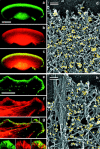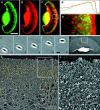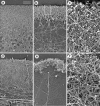Arp2/3 complex and actin depolymerizing factor/cofilin in dendritic organization and treadmilling of actin filament array in lamellipodia
- PMID: 10352018
- PMCID: PMC2133125
- DOI: 10.1083/jcb.145.5.1009
Arp2/3 complex and actin depolymerizing factor/cofilin in dendritic organization and treadmilling of actin filament array in lamellipodia
Abstract
The leading edge (approximately 1 microgram) of lamellipodia in Xenopus laevis keratocytes and fibroblasts was shown to have an extensively branched organization of actin filaments, which we term the dendritic brush. Pointed ends of individual filaments were located at Y-junctions, where the Arp2/3 complex was also localized, suggesting a role of the Arp2/3 complex in branch formation. Differential depolymerization experiments suggested that the Arp2/3 complex also provided protection of pointed ends from depolymerization. Actin depolymerizing factor (ADF)/cofilin was excluded from the distal 0.4 micrometer++ of the lamellipodial network of keratocytes and in fibroblasts it was located within the depolymerization-resistant zone. These results suggest that ADF/cofilin, per se, is not sufficient for actin brush depolymerization and a regulatory step is required. Our evidence supports a dendritic nucleation model (Mullins, R.D., J.A. Heuser, and T.D. Pollard. 1998. Proc. Natl. Acad. Sci. USA. 95:6181-6186) for lamellipodial protrusion, which involves treadmilling of a branched actin array instead of treadmilling of individual filaments. In this model, Arp2/3 complex and ADF/cofilin have antagonistic activities. Arp2/3 complex is responsible for integration of nascent actin filaments into the actin network at the cell front and stabilizing pointed ends from depolymerization, while ADF/cofilin promotes filament disassembly at the rear of the brush, presumably by pointed end depolymerization after dissociation of the Arp2/3 complex.
Figures











Similar articles
-
Interactions of ADF/cofilin, Arp2/3 complex, capping protein and profilin in remodeling of branched actin filament networks.Curr Biol. 2000 Oct 19;10(20):1273-82. doi: 10.1016/s0960-9822(00)00749-1. Curr Biol. 2000. PMID: 11069108
-
Control of actin filament length and turnover by actin depolymerizing factor (ADF/cofilin) in the presence of capping proteins and ARP2/3 complex.J Biol Chem. 1999 Jul 23;274(30):20970-6. doi: 10.1074/jbc.274.30.20970. J Biol Chem. 1999. PMID: 10409644
-
Direct observation of dendritic actin filament networks nucleated by Arp2/3 complex and WASP/Scar proteins.Nature. 2000 Apr 27;404(6781):1007-11. doi: 10.1038/35010008. Nature. 2000. PMID: 10801131
-
Control of actin assembly and disassembly at filament ends.Curr Opin Cell Biol. 2000 Feb;12(1):97-103. doi: 10.1016/s0955-0674(99)00062-9. Curr Opin Cell Biol. 2000. PMID: 10679358 Review.
-
Actin-based motility as a self-organized system: mechanism and reconstitution in vitro.C R Biol. 2003 Feb;326(2):161-70. doi: 10.1016/s1631-0691(03)00067-2. C R Biol. 2003. PMID: 12754935 Review.
Cited by
-
Stress transmission within the cell.Compr Physiol. 2011 Jan;1(1):499-524. doi: 10.1002/cphy.c100019. Compr Physiol. 2011. PMID: 23737186 Free PMC article. Review.
-
There is more than one way to model an elephant. Experiment-driven modeling of the actin cytoskeleton.Biophys J. 2013 Feb 5;104(3):520-32. doi: 10.1016/j.bpj.2012.12.044. Biophys J. 2013. PMID: 23442903 Free PMC article. Review.
-
Unraveling the determinants of protrusion formation.Int J Cell Biol. 2012;2012:402916. doi: 10.1155/2012/402916. Epub 2012 Mar 1. Int J Cell Biol. 2012. PMID: 22500172 Free PMC article.
-
Regulation of local expression of cell adhesion and motility-related mRNAs in breast cancer cells by IMP1/ZBP1.J Cell Sci. 2012 Jan 1;125(Pt 1):81-91. doi: 10.1242/jcs.086132. Epub 2012 Jan 20. J Cell Sci. 2012. PMID: 22266909 Free PMC article.
-
Production of force and movement by polymerization of actin: mechanism and reconstitution in vitro.J Biol Phys. 2002 Sep;28(3):327-33. doi: 10.1023/A:1020353402385. J Biol Phys. 2002. PMID: 23345778 Free PMC article. No abstract available.
References
Publication types
MeSH terms
Substances
Grants and funding
LinkOut - more resources
Full Text Sources
Research Materials

